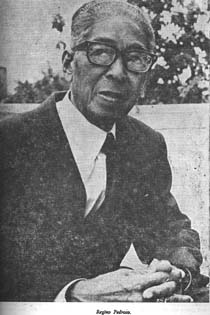4.1.1.10.4 “The tumultuous days”, 1933 – 1936, by Regino Pedroso

The works that make up this collection of poems were written by Regino Pedroso between 1933 and 1936. In general, we see an expansion of his poetic cosmos to include everything human and not only from the perspective of the proletariat, which he nevertheless does not abandon.
From the point of view of its revolutionary conception, the work starts from the exploited condition of the worker to launch into other topics of social significance, among them the fight against fascism and the lyrical tribute to the internationalist heroes and martyrs who participated in the Spanish Civil War, in the figure of Pablo de la Torriente Brau, to whom so many people offered posthumous verses, such as Manuel Navarro Luna himself.
From the point of view of the formal construction of his verses, classical stanzas, which he had shown himself to be a successful cultivator of since his early works, coexist with looser forms to express the social pulse, all with an expressive vigor in which one could appreciate an authentic poeticization of the social motives that had summoned his poetic word.
In these texts, we see how the political content, the direct references with a purely denotative meaning, have given rise to a true poetics with the value of suggestion and the judicious use of a greater number of aesthetic resources, aimed at expanding the sphere of meaning and breaking away from the monosemy typical of political pamphlets; although his art always rose above this elementary treatment of the subject matter.
In this work, the orientalist theme reappears, specifically that of ancient China, with “Two Chinese Poems,” among which, along with the social topic that his works have conveyed since he first ventured into this movement, we can appreciate a true reflection of the sensitivity and wisdom of this magnetized region of the world, without yet abandoning the poetic nature of avant-garde.
Regino Pedroso’s ethics and aesthetics already have a class perspective, which forms the basis for exploring various political and social themes, including racism itself, seen through the lens of economic exploitation as an additional element to the already age-old discrimination. He already understands the necessary unity among all sectors that are in some way exploited, but he does not limit himself to the insular sphere; he broadens his visionary spectrum to the Americas and the world, with lyrical mastery that gives his works a distinctive seal.








